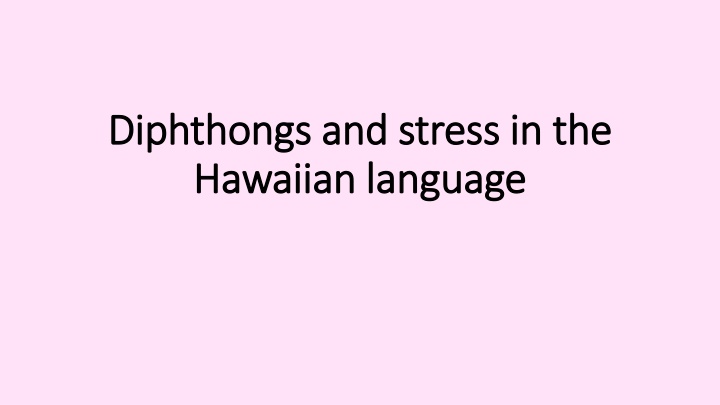
Diphthongs and Word Stress in Hawaiian Language
Explore the intricacies of diphthongs and word stress in the Hawaiian language. Learn how diphthongs create unique sounds and how word stress is applied in Hawaiian words. Discover pronunciation tips and examples to enhance your understanding of the language.
Download Presentation

Please find below an Image/Link to download the presentation.
The content on the website is provided AS IS for your information and personal use only. It may not be sold, licensed, or shared on other websites without obtaining consent from the author. If you encounter any issues during the download, it is possible that the publisher has removed the file from their server.
You are allowed to download the files provided on this website for personal or commercial use, subject to the condition that they are used lawfully. All files are the property of their respective owners.
The content on the website is provided AS IS for your information and personal use only. It may not be sold, licensed, or shared on other websites without obtaining consent from the author.
E N D
Presentation Transcript
Diphthongs and stress in the Diphthongs and stress in the Hawaiian language Hawaiian language
A diphthong is simply two different vowels next to each other (not separated by an okina) which produce one sound. ae ae = yes ai ai = eat ao ao = cloud au au = I ei lei = lei (garland) eu eleu = lively, frisky oe oe = you oi oi = best ou hou = new
All of the other vowel combinations without an okina are pronounced as two syllables. Examples: oa koa = koa wood or tree ua ua = rain (or past tense marker) ea pehea = how
Note that any vowels separated by an okina will always be pronounced as two separate syllables. a o = to teach, learn i a = fish ko u = my po o = head
Some of these sounds are very similar. Practice saying them to feel and hear the difference. ae ai kae kai ao au kao kau ei lei l oe oi koe koi ou hou h
Word stress or accent in Hawaiian generally falls on the next-to-the-last syllable. In grammar books, they call this the penultimate syllable. Examples: lelo = language (accent falls on the e ) pulelehua = butterfly (accent falls on the 2nd u ) kanaka = person (accent falls on the 2nd a ) mahina = moon (accent falls on the i )
The exception to this is a word ending in a diphthong or a vowel with kahak . Examples: Hanalei = a town on Kaua i (accent is on ei ) man = shark (accent is on ) i nehinei = yesterday (accent is on ei ) molo = lazy (accent is on )
A word with both a kahak and a diphthong tend to be pronounced equally, without a strong stress on either syllable. The same is true for a word with two kahak . Examples: h lau = school of hula h nau = birth k w = TV l l = foolish, simple-minded
